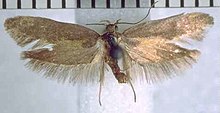Tingena affinis
| Tingena affinis | |
|---|---|

| |
| Male holotype | |
| Scientific classification | |
| Domain: | Eukaryota |
| Kingdom: | Animalia |
| Phylum: | Arthropoda |
| Class: | Insecta |
| Order: | Lepidoptera |
| Family: | Oecophoridae |
| Genus: | Tingena |
| Species: | T. affinis
|
| Binomial name | |
| Tingena affinis | |
| Synonyms[2] | |
| |
Tingena affinis is a species of moth in the family Oecophoridae.[2] It is endemic to New Zealand and has been found in the Nelson region. Adults are on the wing in December and January.
Taxonomy
[edit]This species was described by Alfred Philpott in 1926 using specimens collected in Nelson in December and at Dun Mountain in January.[3] Philpott originally named the species Borkhausenia affinis.[3] Philpott illustrated the male genitalia of this species but this illustration is virtually identical to his illustration of the male genitalia of the species now known as Tingena xanthomicta.[3][2] George Hudson discussed and illustrated this species under the name B. affinis in his 1928 publication The butterflies and moths of New Zealand.[4] In 1988 J. S. Dugdale placed this species within the genus Tingena.[2] The male holotype specimen, collected in Nelson, is held at the New Zealand Arthropod Collection.[2]
Description
[edit]
Philpott described the species as follows:
♂. 13–14 mm. Head, palpi, and thorax bronzy-brown mixed with grey. Antennae brown, narrowly annulated with ochreous, ciliations in male ¾. Abdomen bronzy-brown. Legs brown mixed with grey. Forewings elongate, narrow, not posteriorly dilated, costa slightly arched, sinuate at middle, apex pointed, termen extremely oblique; bronzy-brown; space below fold from near base almost to tornus occupied by a clear yellow stripe; a few yellow scales indicating post-median and pre-apical fasciae: fringes grey with scattered fuscous and yellow points. Hindwings broadly lanceolate; bronzy-fuscous: fringes fuscous with darker basal shade. Belongs to the siderodeta group; the practical absence of fasciae and the dorsal yellow stripe are good distinguishing characters. Nelson in December, and Dun Mountain in January. A single male from each locality.[3]
Distribution
[edit]This species is endemic to New Zealand.[1] It has been found in the Nelson region.[3]
Behaviour
[edit]Adults of this species are on the wing in December and January.[3][4]
References
[edit]- ^ a b Gordon, Dennis P., ed. (2010). New Zealand inventory of biodiversity: Kingdom animalia: chaetognatha, ecdysozoa, ichnofossils. Vol. 2. p. 462. ISBN 978-1-877257-93-3. OCLC 973607714. OL 25288394M. Wikidata Q45922947.
- ^ a b c d e Dugdale , J. S. (23 September 1988). "Lepidoptera - annotated catalogue, and keys to family-group taxa". Fauna of New Zealand. 14. Department of Scientific and Industrial Research: 99. doi:10.7931/J2/FNZ.14. ISSN 0111-5383. Wikidata Q45083134.
- ^ a b c d e f A. Philpott (1926). "New Zealand Lepidoptera: Notes and Descriptions". Transactions and Proceedings of the New Zealand Institute. 56: 391–392. ISSN 1176-6158. Wikidata Q63100760.
- ^ a b Hudson, G. V. (1928), The butterflies and moths of New Zealand, Illustrator: George Hudson, Wellington: Ferguson and Osborn Limited, p. 262, LCCN 88133764, OCLC 25449322, Wikidata Q58593286
